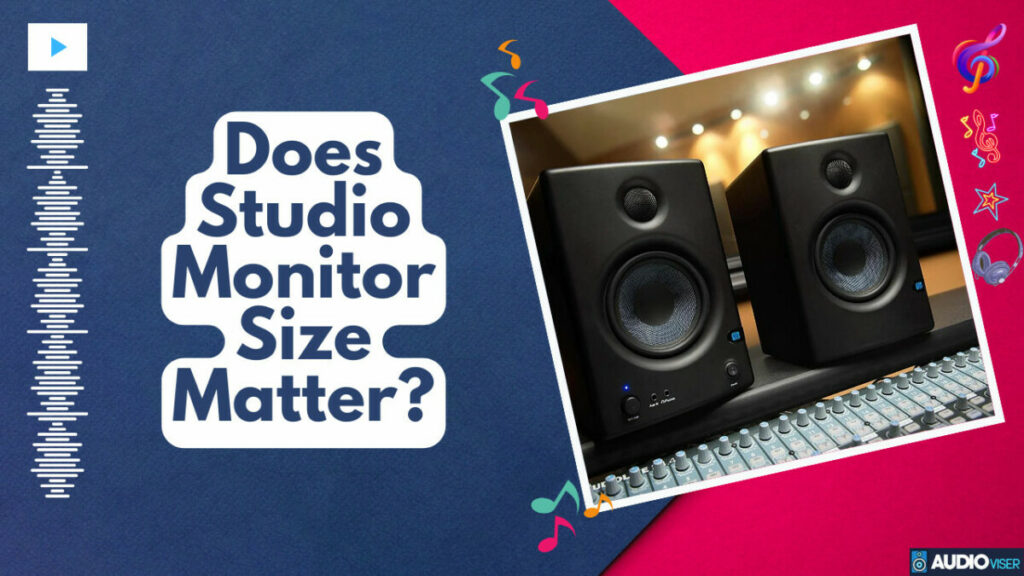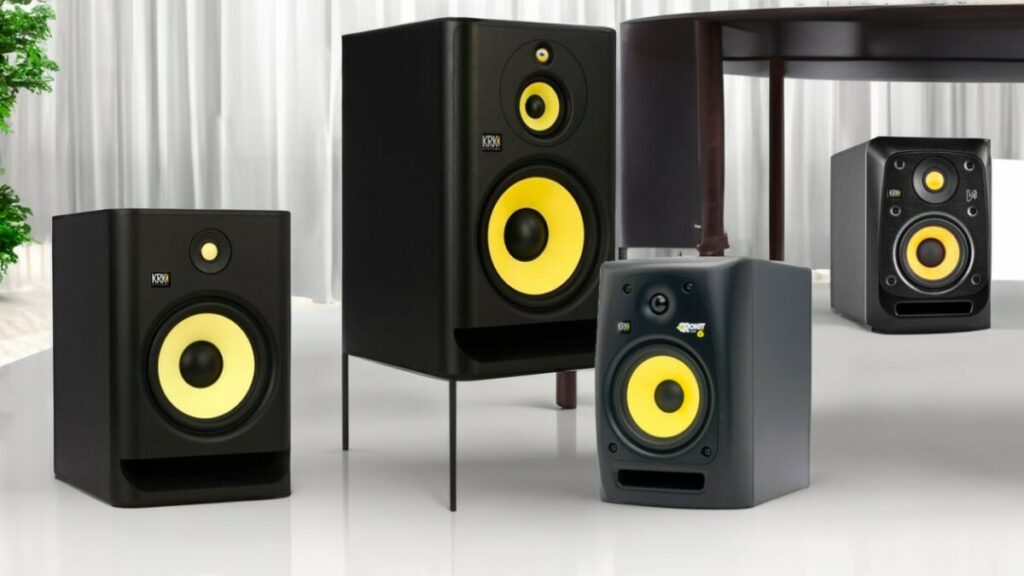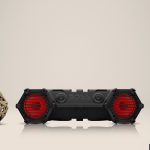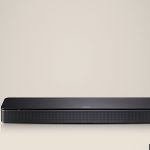Picture this: your studio monitors have your walls pulsating or they’re as soft as a summer breeze. You’re left wondering, does size make a difference?
Strap in, we’re about to delve into the nitty-gritty of studio monitors. We’re going to unravel the intricacies of sound, weigh up different sizes and give you all the know-how to make the ultimate choice.
You’ll be the boss of your sound, no matter the size of your studio monitors. Ready to debunk some myths and crank up the truth? Let’s do this.
Is The Studio Monitor Size Important?
Absolutely, size is a pretty big deal when it comes to studio monitors. The girth of your monitor, specifically the diameter of its drivers, carries a lot of weight when it comes to its frequency response abilities. Bigger monitors, with those fat woofers, typically kill it with reproducing lower frequencies, resulting in a more robust sound filled with deep, juicy bass.
Tiny monitors, on the other hand, might leave you a little bass-hungry, but they’re perfect for tinier rooms where you don’t want your space drowning in bass frequencies.
Essentially, the bigger the monitor, the more it fills the room with sound, especially when it comes to the bass. When picking out your monitor, take a good look at your room size, how you like to listen, and what specific sound jobs you’ll be taking on to make the best choice.
Studio Monitor Sizes and Their Impact
You might be scratching your head, asking yourself how the heck the size of a studio monitor can mess with the sound quality, right? Well, buckle up, because it’s all about the vibe of the room and where you put the monitor.
The size of the monitor sets the bar for the lowest frequency it can rightly belt out. The bigger the monitor, the better it can pump out those low frequencies, compared to the smaller ones.
But hold up, your room’s size and acoustics are big game players too. Popping a large monitor in a small, unoptimized room might just leave you with a sound that’s more ‘bleh’ than ‘boom’. And don’t even get me started on monitor positioning. If it’s too close to walls or corners, you’re going to get bass frequencies that are way over the top. To know more about monitor-wall placement, check out this article on how far should studio monitors be from the wall.
The Science Behind Sound and Monitor Size
Diving into the science of sound and speaker size isn’t exactly a walk in the park. It’s more like trying to ace a physics test on acoustic science and sound wavelengths, both of which play a big part in what you hear. Let’s break it down into three main points:
- Sound is more than just a noise: Picture sound as a wave cruising through the air. The gap between these waves is what we call the wavelength. Now, with larger speakers, you get longer wavelengths, which translates to those deep, earth-shaking bass frequencies you love.
- Speaker size matters: The size of your speakers does play a role in the sound they produce. Basically, the larger the speaker, the better it’s at belting out those low-frequency sounds.
- The role of Acoustic Physics: The room’s size and what it’s made of can have a big impact on how the sound moves around, changing the whole vibe of your listening session.
Comparing Small Vs Large Studio Monitors
When you’re sizing up small and large studio monitors, it’s clear that both bring something different to the table.
| Monitor Size | How Room Size Plays Out | Budget Talk |
|---|---|---|
| Small | They’re compact, so less affected by room vibes, perfect for tiny spaces | Easier on the wallet, great if you’re on a tight budget |
| Large | Bigger impact on room sound—perfect for more spacious areas | They’re a bit of a splurge, but worth it for top-notch setups |
Here’s the lowdown: small monitors pretty much shrug off whatever your room’s acoustics throw at them, making them a strong contender for smaller spaces. On the flip side, though, larger monitors are more sensitive to room sound, which can be a good thing if you’re working in a larger room and want a full, rich sound. Also, let’s be real, the cost factor is a big deal. Small monitors are generally kinder to your bank balance, but if you’re willing to splash out for quality, the advanced features and killer performance of larger monitors might just be your jam.
Factors to Consider When Choosing a Studio Monitor Size
Choosing the right gear for your set-up isn’t just about going big or small, alright? There’s a bunch of stuff you gotta keep in mind. The way you place your monitors and the effect your room has on the sound quality are super important.
- Where You Put Your Monitors: Believe it or not, where you stick your monitors can make a huge difference in how they perform. For the best sound, they need to be at your ear level and pointed towards you.
- The Impact of Your Room’s Acoustics: Your room’s size and shape can seriously mess with certain frequencies, either cranking them up or damping them down. Soundproofing your room and treating it for sound quality can give you that balanced sound you’re after.
- The Size and Power of Your Monitors: Big monitors crank out more volume and bass, while smaller ones deliver more detail when the volume’s down low. Make sure you think about how big your room is and what your listening habits are before you decide.
Does the Placement of Studio Monitors Depend on Their Size?
The height placement of studio monitors does not depend on their size. The main factor to consider is ear level positioning. Regardless of monitor size, placing them at the correct height ensures optimal listening experience and accurate sound reproduction. If you’re working in tight spaces, you might want to learn more about near-field studio monitors.
Real World Applications: How Professionals Choose Monitor Size
When it comes to picking out their gear, pros in sound mixing and music production have a pretty solid checklist they stick to, especially when it’s about speaker sizes. What they look for most is the versatility of the size and how it fits their own personal style.
Take a look at this simple breakdown that shows how speaker size and its use are linked:
| Speaker Size | How It’s Used |
|---|---|
| Small (3-5′) | Perfect for intimate mixing, on-the-go setups, and cozy spaces |
| Medium (6-8′) | Just right for bigger home studios, mid-field mixing |
| Large (10’+) | The go-to for pro studios, and massive recording/mixing spaces |
| Different Sizes | Offers the flexibility, keeps up with changing sound needs |
These guys know what they’re doing. They’re aware of the trade-off between size and sound quality. They know that a big speaker might give more accurate low frequencies, but isn’t always the most practical choice. So, their decisions are typically a blend of convenience and the sound quality they’re aiming for. It’s all about finding that sweet spot, you know?
Sound Artist
I’m a Sound Artist creating immersive sonic experiences. I turn everyday objects into music, turning the mundane into something marvellous!









